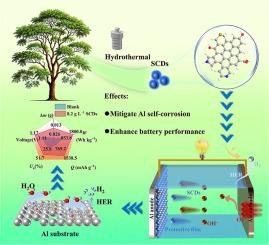生物质碳量子点对铝-空气电池界面的调控:缓蚀和电化学增强
IF 14.3
1区 材料科学
Q1 MATERIALS SCIENCE, MULTIDISCIPLINARY
引用次数: 0
摘要
碱性铝空气电池(AABs)因其卓越的能量密度、低成本和固有的安全性而成为下一代储能技术的有希望的候选者。然而,铝阳极严重的自腐蚀阻碍了它们的实际部署,导致性能下降和使用寿命缩短。本研究创新性地将苦参叶片(SCDs)衍生的碳量子点作为碱性AABs的电解质添加剂,以提高阳极耐腐蚀性并实现高性能输出。腐蚀评价表明,0.2 g L−1 SCDs可以有效调节阳极的界面稳定性,达到41.5%的缓蚀效率。此外,添加SCDs使AABs的阳极利用率达到51.7%,比容量为1538.5 mAh g−1,能量密度为1800 Wh kg−1,明显优于不添加添加剂的AABs。详细的机理分析表明,SCDs在Al表面形成稳定的、平行配置的吸附膜,调节Al的溶解,增强界面完整性,从而促进更可控的电池反应。这项工作为AABs添加剂的选择提供了新的见解,并揭示了碳量子点与Al表面在分子/原子尺度上的相互作用。本文章由计算机程序翻译,如有差异,请以英文原文为准。

Interfacial regulation of aluminum-air batteries by biomass carbon quantum dots: Corrosion inhibition and electrochemical enhancement
Alkaline aluminum-air batteries (AABs) are promising candidates for next-generation energy storage technologies owing to their exceptional energy density, low cost, and inherent safety. However, their practical deployment is hindered by severe self-corrosion of the aluminum anode, leading to performance degradation and a shortened operational lifespan. Here, carbon quantum dots derived from Sophora japonica leaves (SCDs) are innovatively employed as electrolyte additives in alkaline AABs to improve anode corrosion resistance and achieve high-performance output. Corrosion evaluation reveals that 0.2 g L−1 SCDs effectively modulate the interfacial stability of the anode, achieving a corrosion inhibition efficiency of 41.5%. Moreover, incorporating SCDs enables AABs to achieve a high anode utilization of 51.7%, with a specific capacity of 1538.5 mAh g−1 and an energy density of 1800 Wh kg−1, markedly surpassing the additive-free counterpart. A detailed mechanistic analysis indicates that SCDs form a stable, parallel-configured adsorption film on the Al surface, which modulates Al dissolution and enhances interfacial integrity, thereby facilitating more controlled battery reactions. This work offers new insights into the selection of AABs additives and reveals the interaction of carbon quantum dots with the Al surface on a molecular/atomic scale.
求助全文
通过发布文献求助,成功后即可免费获取论文全文。
去求助
来源期刊

Journal of Materials Science & Technology
工程技术-材料科学:综合
CiteScore
20.00
自引率
11.00%
发文量
995
审稿时长
13 days
期刊介绍:
Journal of Materials Science & Technology strives to promote global collaboration in the field of materials science and technology. It primarily publishes original research papers, invited review articles, letters, research notes, and summaries of scientific achievements. The journal covers a wide range of materials science and technology topics, including metallic materials, inorganic nonmetallic materials, and composite materials.
 求助内容:
求助内容: 应助结果提醒方式:
应助结果提醒方式:


